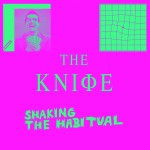The Knife is weird. In the seven years since the band’s last studio album, the critically acclaimed “Silent Shout,” it has continued with rare public appearances in plague doctor masks and Venetian masquerades without much word. Two projects the duo released in the meantime include “Fever Ray,” a solo album by Karin Dreijer Andersson that successfully plays with experimental electronic sounds, and an electro-opera based on Charles Darwin’s “On the Origin of Species.”
“Shaking the Habitual” takes note of both of these works. At nearly 100 minutes long, it’s a tour of political and ambient sightseeing (or hearing) layered into what could potentially be described as a pop album. Those who go into the album with knowledge of what they’re in for will likely find many points of enjoyment. Others may find it a bit painful.
Half of what The Knife does best is exemplified in its two pre-released singles, which also serve as the opening tracks. “A Tooth for an Eye” only slightly diverges from the standard synthetic tone of “Silent Shout” with a percussion-heavy intensity unlike what the rest of the album has to serve. “Full of Fire” is a fierce, industrialized take on the band’s previous electronic style, and is composed of haunting pings and resonating layers to dance to for nine minutes.
Both have a lightly dystopian feel, which is only enhanced by similar songs presented in the coming hour. “Networking” guides a techno beat through the minimalist manipulation of electronic pulses. “Stay Out Here” is quieter, using a duet of Andersson’s wailing vocals and Olof Dreijer’s stronger singing to complement a 10-minute jumble of bass-heavy beats. As only a few of the many appealing individual sounds on The Knife’s experimental adventure, there is a profitable amount to pick and choose from for those who may not be able to handle the album’s remaining shtick.
Those who can handle it will be in for a bigger reward. “Shaking the Habitual” feels like an album experience if there ever was one, a composition of extended takes shaped into a manifesto of lyrical commentary and criticism. Almost half the album’s songs exceed eight minutes in length. None of them segues explicitly into another, yet all play as a thematic sequence of enveloping moods and tones that flow as an album should, with thought-provoking exhilaration.
The critics, as varied and plentiful as they likely are, will find two essentially wrong things that are very hard to argue: at length, the album is boring and pretentious. Fortunately, The Knife displays both of these qualities in its album’s longest and shortest tracks. “Old Dreams Waiting to Be Realized” is a 19-minute drone of ambient electronic feedback with only sporadic changes in small beats and fizzles. “Oryx” is essentially a 30-second instrumental screech.
Both, when displaced from the rest of the tracks, are merely odd compositions to be inevitably passed over and ignored. Others, such as “A Cherry On Top” and “Raging Lung,” take the same hypnotic disconnection from the norm, but complement it with a deliberate deep groove or percussion. Working together as peers in experimental storytelling, they form their intended result of eerie dissonance and oblique meaning with flattering triumph.
The Knife has gone a long way since its 2002 hit “Heartbeats” led it to the forefront of electronic success. The power of the band’s music has only progressed, though it’s debatable whether it has taken a forward or backward direction from the commendations the band once achieved. Reflecting on its ambitiously mesmerizing music and history of anarchy toward the media, it wouldn’t be surprising if the group was perfectly content with the latter.
– Sebastian Torrelio
Email Torrelio at storrelio@media.ucla.edu.
